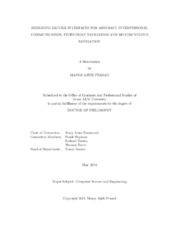| dc.description.abstract | The tactile medium of communication with users is appropriate for displaying information in situations where auditory and visual mediums are saturated. There are situations where a subject's ability to receive information through either of these channels is severely restricted by the environment they are in or through any physical impairments that the subject may have. In this project, we have focused on two groups of users who need sustained visual and auditory focus in their task: Soldiers on the battle field and motorcyclists.
Soldiers on the battle field use their visual and auditory capabilities to maintain awareness of their environment to guard themselves from enemy assault. One of the major challenges to coordination in a hazardous environment is maintaining communication between team members while mitigating cognitive load. Compromise in communication between team members may result in mistakes that can adversely affect the outcome of a mission.
We have built two vibrotactile displays, Tactor I and Tactor II, each with nine actuators arranged in a three-by-three matrix with differing contact areas that can represent a total of 511 shapes. We used two dimensions of tactile medium, shapes and waveforms, to represent verb phrases and evaluated ability of users to perceive verb phrases the tactile code. We evaluated the effectiveness of communicating verb phrases while the users were performing two tasks simultaneously. The results showed that performing additional visual task did not affect the accuracy or the time taken to perceive tactile codes.
Another challenge in coordinating Soldiers on a battle field is navigating them to respective assembly areas. We have developed HaptiGo, a lightweight haptic vest that provides pedestrians both navigational intelligence and obstacle detection capabilities. HaptiGo consists of optimally-placed vibro-tactile sensors that utilize natural and small form factor interaction cues, thus emulating the sensation of being passively guided towards the intended direction. We evaluated HaptiGo and found
that it was able to successfully navigate users with timely alerts of incoming obstacles without increasing cognitive load, thereby increasing their environmental awareness. Additionally, we show that users are able to respond to directional information without training.
The needs of motorcyclists are di erent from those of Soldiers. Motorcyclists' need to maintain visual and auditory situational awareness at all times is crucial since they are highly exposed on the road. Route guidance systems, such as the Garmin, have been well tested on automobilists, but remain much less safe for use by motorcyclists. Audio/visual routing systems decrease motorcyclists' situational awareness and vehicle control, and thus increase the chances of an accident. To enable motorcyclists to take advantage of route guidance while maintaining situational awareness, we created HaptiMoto, a wearable haptic route guidance system. HaptiMoto uses tactile signals to encode the distance and direction of approaching turns, thus avoiding interference with audio/visual awareness. Evaluations show that HaptiMoto is intuitive for motorcyclists, and a safer alternative to existing solutions. | en |


